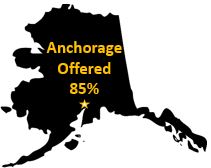- April 21, 2015
- John Belden
- Reading Time: 3 minutes
Why you should not consider this strategy in negotiations with SAP
 Anchorage Alaska, the 63rd most populated city in the US with just over 300,000 inhabitants, achieved an 85% discount on their ERP software from SAP. So how did the city with approximately 2600 employees and an IT department that numbers less than 70 achieve what appears on the surface to be a great deal from SAP?
Anchorage Alaska, the 63rd most populated city in the US with just over 300,000 inhabitants, achieved an 85% discount on their ERP software from SAP. So how did the city with approximately 2600 employees and an IT department that numbers less than 70 achieve what appears on the surface to be a great deal from SAP?
To understand what happened, we need to go back into last century when Anchorage attempted to implement PeopleSoft as its primary ERP package. At a cost of over $20M the implementation was never fully executed and the city was left with an incomplete and aging legacy system. In 2012, assisted by Gartner, the city conducted a RFP process to replace the systems. The selection process came down to two vendors: Oracle and SAP. The city selected SAP along with Black & Veatch as the system integrator. The combined proposal from SAP and Black &Veatch provided for an implementation plan of 18 months at a cost of just under $10M. Anchorage city CIO, Lance Ahem, stated that the primary reason for selecting this combination was the low hourly rate (30% less than Oracle’s) associated with their proposal. The logic behind the selection criteria appeared to be that the reduced hourly rate would keep costs lower on future scope changes, reasoning Lance later identified as being flawed.
Now in 2015, the city is predicting a project cost of approximately $50M dollars with an implementation period of 39 months. Cost growth at 5 times what they originally expected and schedule variance at over 200% was probably not what they envisioned when they signed the contracts in 2012, especially given the fact Anchorage leveraged Gartner as its sourcing advisor. Since 2012, the city has replaced the system integrator, brought in a new CFO to lead the program, and conducted two external audits to assist in setting the program on the right course. One of those external audits was provided by SAP at a cost of $750K. As you might expect, the city council and mayor have not been pleased with the results. As noted in the city council minutes of September 2014, as a sign of good will, SAP offered the following to Anchorage;
- 85% discount on Anchorage’s licensing needs contracted prior to 10/31/2014. This is a higher discount than Anchorage received when it made its original purchase.
- SAP to provide a Solution Engineer for Anchorage at no cost to evaluate the Anchorage payroll configuration.
- SAP to provide Anchorage the ability to make adjustments to the licensing structure over a 12 month period and to provide a hold on its discount.
Anchorage has paid a steep price to achieve this kind of discount from SAP. Here are a few things you can learn from Anchorage;
- If the estimate sounds too good to be true, it probably is. A low initial estimate can generate bad behavior on the project team as corners are cut in order to keep costs within the frame of the low ball quote.
- You get what you pay for. Expecting cut rate resources to come in and provide the same level of advice and counsel is a pipe dream. Project success or failure is largely tied to the level of talent that the organization and the system integrator bring to the table. Starting off with a less then capable team is a recipe for failure.
- Don’t launch the project until you have your own house in order. Lack of available user resources puts the integrator in the position of making the decisions and limits the internal ownership of the project. One of the keys to program success is high engagement levels of top talent from the end-users. In the case of Anchorage, this criteria appears not to have been met.
- Don’t wait until you fail to conduct an audit. Anchorage would have been better served to obtain a program risk review before they launched. By conducting an audit ahead of time, the 3 points identified above would have likely been caught, and Anchorage would have been better prepared for the true costs of a program like this.
An 85% discount from SAP is clearly a good deal, but may have been within reach on the initial negotiations. Before you launch a major program, be sure to give us a call.
We welcome your comments and discussion. At UpperEdge, we see our blog as a forum for communicating practical and actionable insights that are grounded in relevant experience. You may contribute directly to the discussion by commenting below. If you would prefer to discuss separately, please do not hesitate to contact our Governance and Risk Practice Leader, John Belden, at jbelden@upperedge.com.
Related Blogs
7 Key Risks to Consider When Evaluating RISE
5 Predictions for SAP Customers in 2024
SAP vs. 3rd Party Support: Opportunities to Impact Your Maintenance Costs
About the Author
